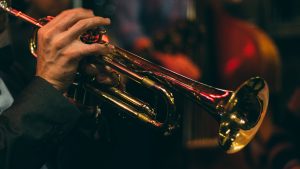Global Youth Conference Music Guidelines
Click here to download a pdf version of the Music Guidelines.
HINTS FROM THE MUSIC JUDGES Most of the music judges’ comments deal with intonation (the ability to sing and play in tune) and rhythmic accuracy. In many musical traditions, and especially in gospel music, it is important for the performer to be able to improvise and make various changes to the composition as it is performed. In this competition, however, the judges are requiring the music to be performed exactly as it is written. Often, student performers have lost many points because they performed a piece according to the way they have heard it in the past instead of the way the music indicates.
 Both vocalists and instrumentalists need to be aware of the fact that good intonation is often made easier by obtaining a qualified instructor who can teach the basics of breathing, posture, and other items that are the foundation of good musical performance.
Both vocalists and instrumentalists need to be aware of the fact that good intonation is often made easier by obtaining a qualified instructor who can teach the basics of breathing, posture, and other items that are the foundation of good musical performance.
Please be aware that the accompaniment is a vitally important part of a musical entry. If the accompanist does not have the ability to easily perform the accompaniment, it will undoubtedly cause the score to be lowered. Recognizing the fact that many published arrangements deliberately simplify piano accompaniments so more pianists can easily perform the music, the judges will allow improvisation in the piano accompaniment; however, this liberty does not extend to the actual contestant.
Do not choose music that is overly difficult in an effort to impress the judges. It is impossible to hide the fact that you are performing music that is beyond your ability. Instead of raising your score by selecting impressive selections, your score will be lowered because you cannot perform the music well. It is better to choose simpler music that you can perform well.
PLEASE carefully review the official GCEA Statement of Acceptable Music in these guidelines before selecting your competition piece. If you have questions about the suitability of a certain piece, please submit it to GCEA for review and approval.
PREPARING FOR THE CONFERENCE
TONE QUALITY
General-Beauty of tonal color
Each instrument or ensemble group possesses a unique characteristic tone quality (color). Performers are expected to achieve this tonal color in performance. Listen to quality recordings of professionals, and strive to match their tonal color as you play. Do not emulate the tonal production of jazz performers, stage bands, or the projection of performers in marching bands. Listen to classical soloists or chamber groups to develop a refined sound. Poor tone quality is usually an indication of improper air concepts on winds instruments, poor bow control on strings, or improper stroking on percussion instruments. Control and stability These terms refer to evenness of tone and ease of tonal production. Control and stability are best achieved by daily, thoughtful practice of long tones and scales throughout the instrument’s range over a long period of time. Be prepared to spend many years of consistent practice developing control and stability of a beautiful tonal color.
Solo Range development Choose a solo that demonstrates your full note range. Solos that require tones that are too high or too low and solos that do not demonstrate the performer’s full range should be avoided or modified.
Embouchure (Winds) The embouchure (lip and jaw function) should work freely to allow the air stream to cause a proper vibration. Obtain the services of a professional private instructor to develop proper embouchure habits.
Ensemble: Balance of parts Keep in mind that the melody line must predominate and that accompanying parts must present a unified foundation for the melody whenever it is present. Group blend Blend the voices of the ensemble so that they present a unified tonal color, one that is characteristic for the type of group that you are presenting. Strive to develop a classical chamber sound.
INTERPRETATION AND MUSICIANSHIP
Phrasing This element, more than any other, separates maturity levels in performance. Only a small percentage of the dynamic and tempo variations are actually indicated in the score. Identify each phrase, and then identify the highest point of intensity within each phrase. Finally, use the tools of expression, tempo, dynamics, and spirit to enhance that point of intensity within each phrase.
Expression, tempo, dynamics, and spirit Strive to present the emotional intent of the composer/arranger and the spiritual qualities of the song’s message (when applicable).
Tradition Some pieces, especially sacred classics, require some understanding of the performance practices of the musical period during which they were written. If you select, for example, a piece from the Baroque period, you would do well to research performance practices (including ornamentation styles) of the period. Please keep in mind that recordings can sometimes be quite misleading since not all recording artists emphasize historically accurate performances.
TECHNIQUE
General (All Instruments) Demonstrate Fluency and overall technical ability Choose a piece that emphasizes your strengths. Fluency refers to technical freedom on the instrument. Many years of faithful practice under the direction of a good teacher are required to develop fluency and a wide-range technical ability. Articulations/fingerings/hand positions/posture
Specific (Instrument Categories) Bells and Chimes Efficiency of stroke technique For individual stroke consistency or group stroke consistency, choose the stroke patterns that produce the styles and expressions which the piece requires. Then practice those patterns carefully under the watchful eye of an instructor to develop consistency.
Remember—PRACTICE MAKES PERMANENT.
Mallets Hand positions/wrist technique/stroke placement on bars or strings A private instructor will be necessary to develop proper hand positions and wrist technique. The goal is to be able to play easily and efficiently. Each bar or string possesses a live spot or a heart that produces the optimum sound for that instrument. Bars also possess a secondary spot which may be utilized for efficiency of movement during fast passages. Learn these spots and practice slowly until you can strike the string or bar on its live spot every time.
Strings Bowing choice and execution While some bowings are marked, most require a decision on the part of the player. Obtain the services of a private instructor or a professional teacher to assist with bowing decisions. Bowing decisions will affect many other areas of your performance.
Winds Breath control and tonguing Proper breath control is evidenced by pure tone quality and freedom in performing many styles of articulation (slurs, staccatos, and a wide variety of accents) at every conceivable dynamic level. The tongue can produce proper articulations only within the context of a well-controlled stream of air. 
RHYTHM Precision Rhythmic precision refers to the accurate execution of each written rhythmic figure. Any variation to the written rhythms should be noted on each judge’s copy of the music.
Meter Each time signature receives its own characteristic pulsation within every measure. This pulsation seldom varies throughout the piece unless it is interrupted by special articulations. The performer must learn the metrical pattern of each time signature so that the pulsation and variations in that pulsation can achieve the intended effects.
Rhythmic figure interpretation Not only is rhythmic precision important, but it is also important to achieve the interpreted style of unique rhythmic figures. For instance, in a march the dotted eighth and sixteenth figure must be treated differently than that same figure when found in a fanfare. Likewise, a triplet across two beats is likely to be performed in two different ways in a classical minuet and in a lullaby. It is also likely to be treated differently at the height of a phrase than from that at the end of a musical section. It may be helpful to secure the assistance of a professional instructor to guide in this area.
Accents Give special attention to every accent (both written accents and accents that are implied by the meter). There are several types of accents, and each style of piece requires its own special treatment of accents. Also, accents are performed at different intensities, depending on the dynamic level at the time.
INTONATION Winds and strings Individual (Solo) and Group (Ensemble) Winds must be aware that many notes on even the most carefully manufactured instruments are out of tune. These tones must be found (a portable tuner is a great help) and humored into tune. String players must learn accurate pitch placement and must adjust out-of-tune pitches quickly. Groups must practice slowly and carefully to achieve unity of pitch. Practice unison or octave scales in pairs, carefully tuning every tone before moving on, to develop good group intonation skills.
Pretuned instruments in lieu of intonation (Bells, Chimes, and Mallets) Execution/consistency/stability of stylistic and dynamic contrasts Every consecutive percussive stroke at a dynamic level must achieve a consistent volume level. Also, consecutive strokes in a crescendo or decrescendo must produce smooth dynamic variation. Correct choice of mallets for each style/dynamic Mallets come in many different materials and tensions to produce different tone qualities and dynamics. Most performances benefit when the mallets are selected according to the musical needs.
PRESENTATION Suitability to ability Choose a piece that clearly shows your ability, keeping in mind that a piece does not need to be difficult to be musically excellent and to minister to fellow believers.
Suitability of musical style Follow the suggested guidelines carefully. Keep in mind that the music itself will develop an atmosphere. That atmosphere should be consistent with the spirit of the song and the spirit of the service in which the piece is being played.
Stage presence (Soloist) and stage appearance (Ensemble) Soloists should try to present a spirit of quiet confidence. Do not look at the judges or audience while playing. You may look at each other if doing so enhances musical communication and performance. Simply concentrate on the music. Ensembles should try to sit or stand in an attractive formation. Give each instrument plenty of room. Make sure your performance area is attractive and orderly. Develop a simple, silent, hidden (if possible) starting signal.
Entrance and exit Take some time to develop an orderly entrance and exit. Look positive from the time that you enter the performing area to the time that you leave.
Clothing Follow GCEA Student Convention Guidelines. A special uniform for large groups lends much to the overall effect of the presentation. Contestants who do not meet GCEA dress guidelines will be asked to return for their performance when they are properly dressed.
Time limit Time your piece when you are selecting it. Choose a piece that fits easily into the time limit. Cuts and tempo variations to make the time limit are often quite distracting. NOTE: Musical competition time limit is five (5) minutes. If competition piece exceeds the five (5) minute time limit, the contestant will receive a .5-point deduction for any portion of thirty (30) second increments. (For example, a piece timed at 5:12 would receive a half-point deduction from the total score. A piece at 5:42 would receive a deduction of a full point from the total score.)

